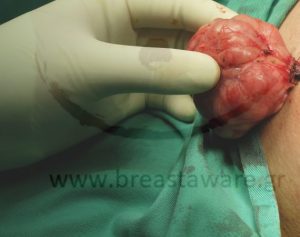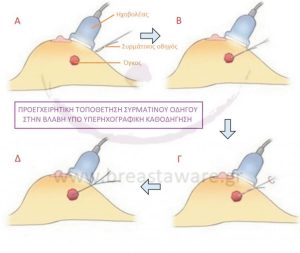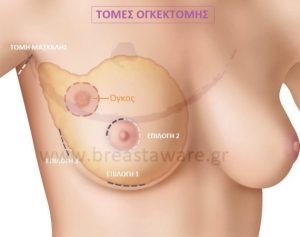Breast Lumpectomy: An Effective Breast-Conserving Option
The breast lumpectomy, also known as breast conservation surgery, is a modern and targeted procedure for the removal of breast cancer or other suspicious lesions, without the need for a total mastectomy. Unlike mastectomy, lumpectomy removes only the pathological part of the gland along with a small amount of healthy surrounding tissue, ensuring clear surgical margins (negative resection margins).
The operation offers equivalent oncological results with mastectomy, when combined with postoperative radiotherapy, while it is aesthetically and psychologically superior for many women.
How Is the Lesion Located Before Surgery?
The fault may have been detected by mammography, tomosynthesis mammography or breast ultrasound, while it has preceded biopsy with core needle. If the lesion is not palpable, a radiopaque or magnetic clip to the lesion for future identification. On the day of surgery, a thin guide wire is inserted (hook wire), which helps the surgeon to accurately locate the resection site. In case of placement of a magnetic clip, the guide wire is not needed and the location is done with a special portable detector.
If the lesion is palpable, wire placement is not required.

How Is the Lumpectomy Performed?
The operation is performed under general anesthesia. The surgeon makes a discreet incision in the breast, usually around the areola or in a location that offers a better aesthetic result. In cases invasive cancer, follows sentinel lymph node biopsy or axillary lymph node dissection, depending on the stage of the disease.
Most cases do not require drainage tubes in the excision cavity.
Postoperative Care
After the lumpectomy, the woman can be discharged the same day or the next day. Most women experience mild pain or numbness at the site of the surgery. The final histological examination is available within 1-2 weeks.
During recovery, it is recommended to use sports bra for support, avoiding sudden movements and lifting weights. The breast shape is minimally affected, maintaining the symmetry and the woman's self-image.

Radiotherapy After Lumpectomy
The postoperative radiotherapy is a key step in dealing with early breast cancer after lumpectomy. It is performed in daily sessions for 5 to 7 weeks, with the aim of eliminating any remaining cancer cells. This approach has been scientifically documented to offer same survival rates as mastectomy, according to international studies (EBCTCG, JCO 2020).
Are There Limitations to Lumpectomy?
The lumpectomy is not suitable for all cases. The main contraindications include:
- Multiple lesions in different quadrants
- Large tumor relative to small breast size
- Previous breast radiation
- Extensive presence πολυσκενής or multifocal disease
- Difficulty achieving clear margins
- Pregnancy (due to need for radiotherapy)
- Limited access to radiotherapy centers
- Autoimmune diseases affecting healing
- Patient preference for mastectomy
In these cases, it is advisable to total mastectomy, sometimes with simultaneous breast reconstruction.
Complications and Risks
Complications from lumpectomy are rare and may include:
- Bleeding or hematoma
- Infection or inflammation
- Pain, tenderness, swelling, or firmness
- Change in breast shape (especially with large tissue removal)
Proper surgical technique and thorough preoperative evaluation minimize these risks.

Empower Yourself with Informed Choices
The lumpectomy is an extremely effective option for many women with early breast cancer, combining the security of complete exemption with the maintaining femininity and quality of life. Talk to him/her breast surgeon μαστού you for the best approach according to your personal diagnosis and needs.
At breastaware.gr you’ll find reliable, scientifically supported, and patient-friendly information covering all stages of breast cancer prevention, diagnosis, and treatment. Our goal is to empower every woman to feel informed, confident, and supported at every step.
Bibliography – Scientific Sources
- Early Breast Cancer Trialists’ Collaborative Group (EBCTCG). Effect of radiotherapy after breast-conserving surgery for early breast cancer: 20-year follow-up of randomized trials. Lancet. 2021;397(10270):1038–1046.
- NCCN Guidelines: Breast Cancer. Version 4.2025.
- Fisher B, Anderson S, et al. Twenty-year follow-up of a randomized trial comparing total mastectomy, lumpectomy, and lumpectomy plus irradiation for the treatment of invasive breast cancer. N Engl J Med. 2002;347(16):1233–1241.
- Kaufman CS, et al. Radiation therapy after breast-conserving surgery: new techniques and schedules. Breast J. 2020;26(3):382–389.
- American Society of Breast Surgeons (ASBrS). Consensus Guideline on Breast-Conserving Surgery for Breast Cancer. 2022 update.
- Morrow M, et al. Surgical margins in lumpectomy for breast cancer—bigger is not better. N Engl J Med. 2023;388(4):334–340.
- McKevitt EC, et al. Patient-reported cosmetic outcomes after breast-conserving therapy: A review of the literature. Ann Surg Oncol. 2020;27(2):446–456.
